
Macaws are a group of New World parrots that are long-tailed and often colorful. They are popular in aviculture or as companion parrots, although there are conservation concerns about several species in the wild.

The Nightcap National Park is a national park situated within the Nightcap Range in the Northern Rivers region of New South Wales, Australia. The 8,080-hectare (20,000-acre) park was created in April 1983 and is situated 35 kilometres (22 mi) north of Lismore. The park was established following campaigns and blockades against logging at Terania Creek, Grier's Scrub and Mount Nardi between 1979 and 1982. Sections of the Whian Whian state forest were added to it following blockading and campaigning in 1998. The national park is classed by the IUCN World Commission on Protected Areas as Category II and is part of the Shield Volcano Group of the World Heritage Site Gondwana Rainforests of Australia inscribed in 1986 and added to the Australian National Heritage List in 2007.
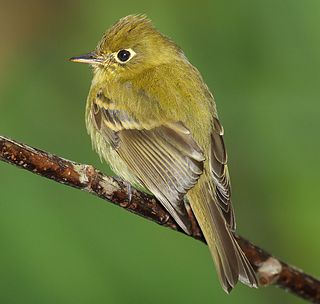
The tyrant flycatchers (Tyrannidae) are a family of passerine birds which occur throughout North and South America. They are considered the largest family of birds known to exist in the world, with more than 400 species. They are the most diverse avian family in every country in the Americas, except for the United States and Canada. The members vary greatly in shape, patterns, size and colors. Some tyrant flycatchers may superficially resemble the Old World flycatchers, which they are named after but are not closely related to. They are members of suborder Tyranni (suboscines), which do not have the sophisticated vocal capabilities of most other songbirds.

The regent honeyeater is a critically endangered bird endemic to southeastern Australia. It is commonly considered a flagship species within its range, with the efforts going into its conservation having positive effects on many other species that share its habitat. Recent genetic research suggests it is closely related to the wattlebirds.

The swift fox is a small light orange-tan fox around the size of a domestic cat found in the western grasslands of North America, such as Montana, Colorado, New Mexico, Kansas, Oklahoma and Texas. It also lives in southern Manitoba, Saskatchewan and Alberta in Canada, where it was previously extirpated. It is closely related to the kit fox and some mammalogists classify them as conspecific. However, molecular systematics imply that the two species are distinct. Interbreeding between the two species does occur where their ranges overlap, but this hybridization is quite restricted in scope.

Buglife – The Invertebrate Conservation Trust is a UK-based nature conservation charity.

Atelopus is a large genus of Bufonidae, commonly known as harlequin frogs or toads, from Central and South America, ranging as far north as Costa Rica and as far south as Bolivia. Atelopus species are small, generally brightly colored, and diurnal. Most species are associated with mid-to-high elevation streams.

The black-bellied tern is a tern found near large rivers in the Indian subcontinent, its range extending from Pakistan, Nepal and India to Myanmar. It has become very scarce in the eastern part of its range and the International Union for Conservation of Nature has assessed its conservation status as being endangered.
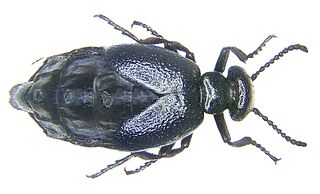
Meloe brevicollis is a European oil beetle. It is also known as the short-necked oil beetle.
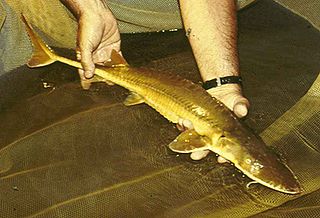
The Alabama sturgeon is a species of sturgeon native to the United States of America and now only believed to exist in 130 miles (210 km) of the lower Alabama River. The fish has a distinctive yellowish-orange color, grows to a size of about 30 in (76 cm) long and 2 to 3 lb (0.9–1.4 kg), and is believed to have a lifespan of 12 to 20 years. Biologists have known of the fish since the 1950s or 1960s, but the large diversity of aquatic species in Alabama prevented formal identification until 1991.
"Litoria" castanea, also known as the yellow-spotted tree frog, New England swamp frog, tablelands bell frog, or yellow-spotted bell frog, is a species of frog in the subfamily Pelodryadinae. It is a critically endangered species of frog that is endemic to south-eastern Australia.
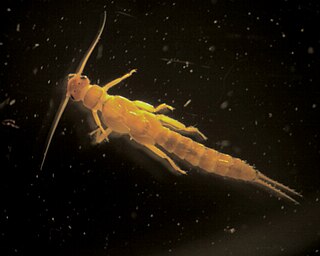
Chloroperlidae are a family of stoneflies, commonly known as green stoneflies, with more than 200 species and 22 genera. They appear green to yellow in colour, and are popularly used among fisherman as bait for trout fishing. Green stoneflies live in the benthic zone of the cold streams and rivers of five continents and four zoogeographical regions, emerging from the water to live in the riparian zone as adults. They are sensitive to pollutants, making them an indicator species for determining the quality of water bodies. Chloroperlidae are hemimetabolous, having no pupal stage, but instead hatch from eggs as nymphs and mature directly into adults. They are omnivorous, feeding on small organisms and plant particles, and become more carnivorous as they mature. The classification of Chloroperlidae is contested, with some believing that they should be considered as members of different orders, as opposed to the order Plecoptera that they currently belong to.

Lednia is a monotypic genus, containing the single species Lednia tumana —a rare, alpine, aquatic insect that is endangered due to likely loss of glaciers and snowpacks in the Glacier National Park and other habitat in the Rocky Mountains due to climate change. The differentiation from the other Nemourids is to look at the abdominal stremite which only the Lednia and paranemoura lack the vesicles of the 9th abdominal stermite. The insect lives in the coldest streams just downstream of the glacier or snowbank sources and is considered as an early warning indicator species of climate warming in mountain ecosystems.The way the aquatic insects in this case Lednia tumana is able to use biochemical and physiological strategies in order to dimmish cold stress which allows them to survive colder climates The Fisheries and Wildlife Service is being petitioned to protect the species under the U.S..Endangered Species Act.

Canvey Wick is a 93.2-hectare (230-acre) Site of Special Scientific Interest at the south-west corner of Canvey Island in Essex. It is owned by The Land Trust and 18.5 hectares is managed by the Royal Society for the Protection of Birds and Buglife as a nature reserve, who are working to bring more of the area under management and to improve public access.
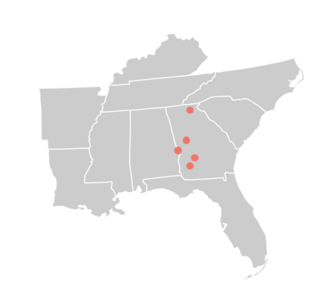
The Halloween darter is a small freshwater fish native to North America. It is found in Georgia and Alabama in the drainage basin of the Apalachicola River, specifically in the Flint River system and the Chattahoochee River system. It prefers shallow, fast-flowing areas with gravel bottoms in small and medium-sized rivers. It was first described in 2008, having not previously been distinguished from the Blackbanded darter (P. nigrofasciata), formerly though to occur in the same watershed. Blackbanded darter has since been split again with Westfall's darter now recognised from the Apalachicola drainage. The species is somewhat variable, being generally blackish dorsally, with some individuals having indistinct saddle-like barring. Males have orange and dark lateral striping while females have dark stripes and a yellowish-green belly. At a maximum standard length of 101 mm (4 in), males are slightly larger than females, and both sexes develop distinctive orange barring on the edge of the first dorsal fin during the breeding season.
Karim Vahed FRES is a British entomologist. He is a professor of entomology and England manager at invertebrate conservation charity Buglife, and is an expert in crickets and bushcrickets (katydids).
The southern stuttering frog is a large species of frog endemic to south-eastern Australia. It is found in mid-eastern New South Wales and at least formerly Victoria, where it ranges from Carrai National Park south to East Gippsland. It inhabits temperate and subtropical rainforest, wet sclerophyll forest, and moist gullies in dry forests.













